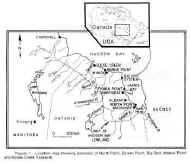|
Naturaliste can. (Rev. Ecol. Syst.), 109
(1982), 399-414
MARSH FORAMINIFERA ZONATIONS IN WESTERN
JAMES AND HUDSON BAYS
D.B. SCOTT1 and I.P. MARTINI2
1Department
of Geology, Dalhousie University, Halifax, Nova Scotia B3H 3JS
2Department
of Land Resource Science, University of Guelph, Guelph, Ontario N1G 2W1
¡¡
 In comparison with more temperate areas,
there are few marsh foraminiferal species in James-Hudson Bay marshes. However,
a unique upper marsh fauna (100-120 cm above mean sea level) consisting of Trochammina
macrescens and Polysaccammina ipohalina was present in two of
the five transects. Low marsh areas contained varying amounts of reworked
calcareous species from raised Tyrrell Sea deposits together with rare T.
macrescens and, in one case at North Point, Miliammina fusca. Total
numbers of individuals were low <100/10 cm3) as compared with
populations in temperate marshes (>1000/10 cm3). In comparison with more temperate areas,
there are few marsh foraminiferal species in James-Hudson Bay marshes. However,
a unique upper marsh fauna (100-120 cm above mean sea level) consisting of Trochammina
macrescens and Polysaccammina ipohalina was present in two of
the five transects. Low marsh areas contained varying amounts of reworked
calcareous species from raised Tyrrell Sea deposits together with rare T.
macrescens and, in one case at North Point, Miliammina fusca. Total
numbers of individuals were low <100/10 cm3) as compared with
populations in temperate marshes (>1000/10 cm3).
There appeared to be a
north-south trend with more species occurring in the southern areas (North Point
and Ekwan Point) than in northern transects. However, one northern transect was
strongly influenced by a river (Goose Creek) and another had poor upper marsh
development (Big Spit) which could account for some of the observed variation.
The observed upper marsh fauna can be used to relocate former
sea levels to an accuracy of ¡À 10 cm. Cautious use of comparable assemblages
because of their reduced specimen numbers should enable the reconstruction of a
very accurate emergence curve using samples from the peat deposits that are
preserved in long series of raised shorelines throughout the Hudson Bay Lowland.
|